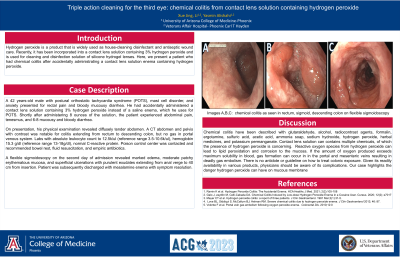Tuesday Poster Session
Category: Colon
P3150 - Triple Action Cleaning for the Colon: Chemical Colitis from a Contact Lens Solution Containing Hydrogen Peroxide
Tuesday, October 24, 2023
10:30 AM - 4:00 PM PT
Location: Exhibit Hall

Has Audio
- XL
Xue Jing Li, MD
University of Arizona College of Medicine
Phoenix, AZ
Presenting Author(s)
Xue Jing Li, MD1, Yasmin Alishahi, MD2
1University of Arizona College of Medicine, Phoenix, AZ; 2University of Arizona, Phoenix, AZ
Introduction: Hydrogen peroxide is a product that is widely used as house-cleaning disinfectant and antiseptic wound care. Recently, it has been incorporated into a contact lens solution containing 3% hydrogen peroxide and is used for cleaning and disinfection solution of silicone hydrogel lenses. Here, we present a patient who had chemical colitis after accidentally administrating a contact lens solution enema containing hydrogen peroxide.
Case Description/Methods: A 42 years-old male with postural orthostatic tachycardia syndrome, mast cell disorder, and anxiety presented for rectal pain and bloody mucousy diarrhea. He had accidentally administered a contact lens solution containing 3% hydrogen peroxide instead of a saline enema. Shortly after administering 8 ounces of the solution, the patient experienced abdominal pain, tenesmus, and 6-8 mucousy and bloody diarrhea.
On presentation, the patient’s physical examination revealed diffusely tender abdomen. CT abdomen and pelvis with contrast was notable for colitis extending from rectum to descending colon, but no gas in portal venous system. Labs with absolute leukocyte count to 12.5k/ul (reference range 3.5-10.6k/ul), hemoglobin 15.3 g/dl (reference range 13-18g/dl), normal C-reactive protein. Poison control center was contacted and recommended bowel rest, fluid resuscitation, and empiric antibiotics. A flexible sigmoidoscopy on the second day of admission revealed marked edema, moderate patchy erythematous mucosa, and superficial ulcerations with purulent exudates extending from anal verge to 40 cm from insertion. Patient was subsequently discharged with mesalamine enema with symptom resolution.
Discussion: Chemical colitis have been described with glutaraldehyde, alcohol, radiocontrast agents, formalin, ergotamine, sulfuric acid, acetic acid, ammonia soap, sodium hydroxide, hydrogen peroxide, herbal medicines, and potassium permanganate. Contact lens solution can contains multiple chemicals, of which the presence of hydrogen peroxide is concerning. Reactive oxygen species from hydrogen peroxide can lead to lipid peroxidation and corrosion to the mucosa. If the amount of oxygen produced exceeds maximum solubility in blood, gas formation can occur in in the portal and mesenteric veins resulting in deadly gas embolism. There is no antidote or guideline on how to treat colonic exposure. Given its readily availability in various products, physicians should be aware of its complications.

Disclosures:
Xue Jing Li, MD1, Yasmin Alishahi, MD2. P3150 - Triple Action Cleaning for the Colon: Chemical Colitis from a Contact Lens Solution Containing Hydrogen Peroxide, ACG 2023 Annual Scientific Meeting Abstracts. Vancouver, BC, Canada: American College of Gastroenterology.
1University of Arizona College of Medicine, Phoenix, AZ; 2University of Arizona, Phoenix, AZ
Introduction: Hydrogen peroxide is a product that is widely used as house-cleaning disinfectant and antiseptic wound care. Recently, it has been incorporated into a contact lens solution containing 3% hydrogen peroxide and is used for cleaning and disinfection solution of silicone hydrogel lenses. Here, we present a patient who had chemical colitis after accidentally administrating a contact lens solution enema containing hydrogen peroxide.
Case Description/Methods: A 42 years-old male with postural orthostatic tachycardia syndrome, mast cell disorder, and anxiety presented for rectal pain and bloody mucousy diarrhea. He had accidentally administered a contact lens solution containing 3% hydrogen peroxide instead of a saline enema. Shortly after administering 8 ounces of the solution, the patient experienced abdominal pain, tenesmus, and 6-8 mucousy and bloody diarrhea.
On presentation, the patient’s physical examination revealed diffusely tender abdomen. CT abdomen and pelvis with contrast was notable for colitis extending from rectum to descending colon, but no gas in portal venous system. Labs with absolute leukocyte count to 12.5k/ul (reference range 3.5-10.6k/ul), hemoglobin 15.3 g/dl (reference range 13-18g/dl), normal C-reactive protein. Poison control center was contacted and recommended bowel rest, fluid resuscitation, and empiric antibiotics. A flexible sigmoidoscopy on the second day of admission revealed marked edema, moderate patchy erythematous mucosa, and superficial ulcerations with purulent exudates extending from anal verge to 40 cm from insertion. Patient was subsequently discharged with mesalamine enema with symptom resolution.
Discussion: Chemical colitis have been described with glutaraldehyde, alcohol, radiocontrast agents, formalin, ergotamine, sulfuric acid, acetic acid, ammonia soap, sodium hydroxide, hydrogen peroxide, herbal medicines, and potassium permanganate. Contact lens solution can contains multiple chemicals, of which the presence of hydrogen peroxide is concerning. Reactive oxygen species from hydrogen peroxide can lead to lipid peroxidation and corrosion to the mucosa. If the amount of oxygen produced exceeds maximum solubility in blood, gas formation can occur in in the portal and mesenteric veins resulting in deadly gas embolism. There is no antidote or guideline on how to treat colonic exposure. Given its readily availability in various products, physicians should be aware of its complications.

Figure: Images A,B,C: visualization of rectum, sigmoid, descending colon on flexible sigmoidoscopy
Disclosures:
Xue Jing Li indicated no relevant financial relationships.
Yasmin Alishahi indicated no relevant financial relationships.
Xue Jing Li, MD1, Yasmin Alishahi, MD2. P3150 - Triple Action Cleaning for the Colon: Chemical Colitis from a Contact Lens Solution Containing Hydrogen Peroxide, ACG 2023 Annual Scientific Meeting Abstracts. Vancouver, BC, Canada: American College of Gastroenterology.
